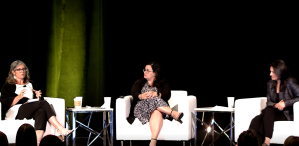The Future of Office? An Ecosystem Mindset.
Experts at CREW’s 2021 convention discuss the evolving notion of what an office means to a company.

Rebecca Udell, Angie Earlywine and Wendy Feldman Block discuss the future of the office at the 2021 CREW Network Convention.
It’s a whole new world for office tenants looking to bring their employees back into the workplace.
The U.S. office market experienced a wave of change over the last 18 months, from a spike in vacancy rates, a sharp dip in leasing activity, and the availability of sublease space hitting an all-time high. While some markets—namely San Francisco and New York City—felt the impact more than others, no area has been immune to the shifting view of how and where employees work.
That changing picture was the subject of a session yesterday at the 2021 CREW Network Convention in Las Vegas. A panel of office experts discussed the historic changes the sector has experienced since the onset of the pandemic, the idea of an office “ecosystem,” and what the future of the office will look like.
Office sector snapshot
It’s no secret the office market has experienced unprecedented headwinds since last year. Across the U.S., overall leasing activity is down significantly from pre-pandemic levels. According to data from Savills, volume is down 42 percent year-to-date, compared to the same time period in 2019.
Availability of office space in the second quarter of 2021 reached 26.2 percent overall, with the highest change belonging to San Francisco, which experienced a staggering jump in available space of 1,520 basis points since the pandemic began. Meanwhile, the highest office availability at the moment is in Houston, the country’s fourth largest city, which topped the charts at 31 percent.
Concessions are at unheard of levels, with Washington, D.C.’s office market recording the highest number of tenant concession packages for Class A trophy product in the U.S., increasing 30.9 percent since the start of the pandemic, according to Savills.
“Even for non-trophy products, initial offers we’re getting so far exceed the best deals we could’ve gotten in 2019,” said Savills Executive Managing Director Wendy Feldman Block during the session. “It’s mind-boggling.”
Cities with strong life sciences and tech sectors—like Boston, Raleigh, and Baltimore—were not as hard hit as others, while other major markets like New York City have started to rebound in 2021.
Deciding factors
One of the biggest challenge for tenants going forward is making their office a place that employees want to be. As the pandemic stretches into its second year and many office workers have gotten used to working remotely, what will make them want to come back?
“There has to be a reason to go back, and it will be different for every organization,” said Rebecca Udell, executive director of marketing strategy at KSS Architects. “You can’t replicate office culture at home, it’s hard to do.”
Udell pointed to office design focused on natural light, natural materials, and a connection to nature as the key to driving workers back.
One big driver for being back in an office setting is the human connection. Surveys have found that personal connections and continued learning have suffered as a result of employees working remotely, with workers reporting taking more sick days and an increase in mental health issues from prior years. And for those in the earlier stages of their careers, not being able to connect with mentors or advocates virtually has been an obstacle.
“They may have a roommate and no separate office space,” said Angie Earlywine, senior director of the Total Workplace practice of Global Occupier Services at Cushman & Wakefield, pointing out that for many workers, their home working space may not be ideal or comfortable.
READ ALSO: When to Expect a Back-to-Office Surge
“As we think about designing the physical office for experiences, if people are only coming in one day a week or even one day a month, they’re more of a visitor to the space,” she said, adding that many companies are looking at their facilities management divisions to create positive experiences at the workplaces, like bringing in special food amenities to encourage people to come back.
Adding to the struggle is what’s been dubbed “The Great Resignation,” a nationwide movement that has seen workers quitting and changing jobs at the highest level it’s been since being measured decades ago. That power shift has led to more companies offering flexible and hybrid schedules.
“It’s not an office, it’s an ecosystem,” said Earlywine. “Employees expect flexibility and choice.”
As turbulent as the last 18 months have been for the office market and the entire county, that newfound choice for workers has been one of the few bright spots to emerge.
“In my line of business, it’s all about people and I think people have won this battle of choice,” said Earlywine. “Never have I seen executives being open to people being able to choose how they work. If we want to entrust and empower people in how they can work, I think we’ve proven we can be successful working in many places. I’m hoping the silver lining is that choice wins.”







You must be logged in to post a comment.